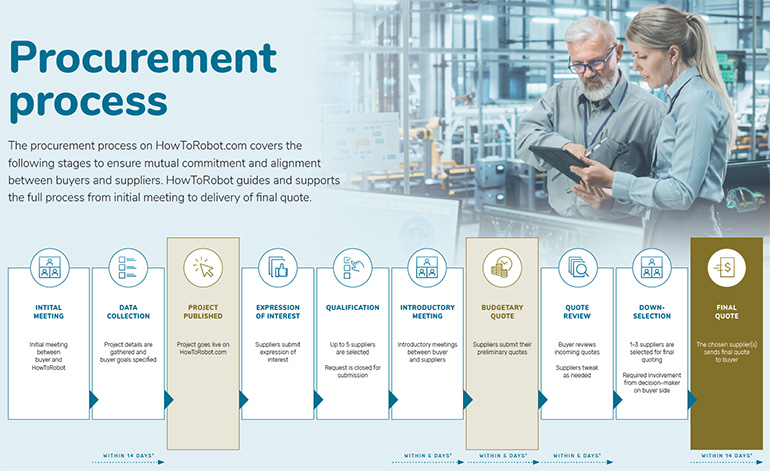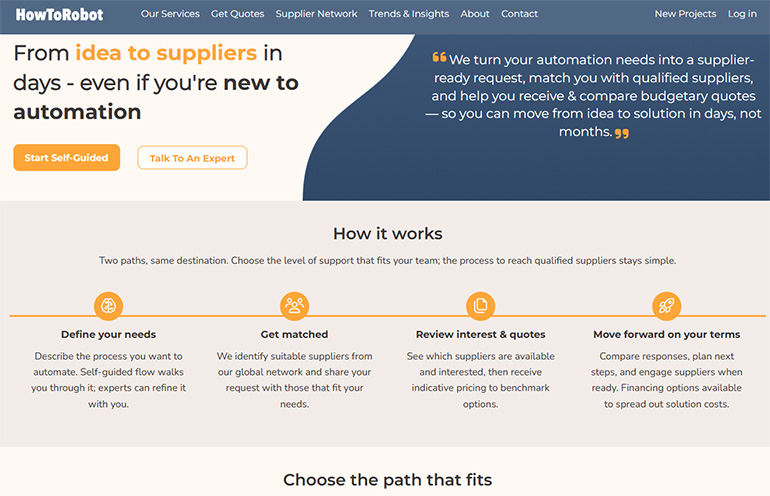
HowToRobot works with suppliers such as Columbia Okura on automating palletizing. Source: HowToRobot
One hurdle to adopting automation is the time spent getting competitive quotes. It can take months to scope projects, develop specifications, and call for proposals. Last month, HowToRobot announced a new sourcing service that uses artificial intelligence to ask buyers about their needs. It then creates a structured project brief that is sent to suppliers.
Even as robot adoption increases among manufacturers and supply chains worldwide, talent is scarce, noted HowToRobot. It said its new service can help define requirements, match suppliers, review quotes, and arrange financing in days.
The Fredriksberg, Denmark-based company said its service taps its global network of more than 20,000 suppliers of sensors, end effectors, and other robotics components, as well as complete systems. The AI is built on learnings from over 600 automation projects and 2,000 supplier proposals, according to Søren Peters, co-CEO of HowToRobot.
HowToRobot offering comes from consulting work
“We grew out of consultancy, and when we launched the marketplace, I thought it would be simple to get a guy to post his projects and then get vendors on the other side,” Peters told The Robot Report. “But that wasn’t the case at all.”
One problem was that buyers new to automation didn’t know how to scope projects — for instance, should a palletizer come with a labeling function?
“Then, when vendors reacted, they said, ‘OK, so you want to make pigs fly? OK, we’ll send you an offer on that,’” he recalled. “The price was crazy, and it was a pilot project. And then the buyer went back and calculated his ROI [return on investment], and it was no good.”
HowToRobot realized that it had two types of clients — those that want to automate but don’t know where to start, and others that may have been to some trade shows and have a good idea of what they want, said Peters.
The company wanted to get beyond having to spend $4,500 sending a freelancer to visit a factory to evaluate what tasks could benefit from automation. HowToRobot built its service on experience with defining processes and requests for information (RFIs) in applications such as welding.

Service gets smarter, includes humans in the loop
“We learned the 20 to 30 most important things that we need to know before we can send a welding request to a vendor to get a decent quote back,” Peters explained. “Instead of asking you to describe your process, it says, ‘So you’re in welding in automotive. That normally means these 10 processes — is this how yours works?’ It’s much easier because then the person can say, ‘Yes, but we don’t do Step 10.’ It suggests instead of you needing to know everything.”
In its current phase, the new HowToRobot service focuses on specific applications, such as palletizing and welding, rather than broader industries. It is increasingly able to guide users through the specification and proposal process.
“My brother is in construction, and he was able to use it,” said Peters. “For people with working knowledge of their factories or specific processes, the AI is fairly simple. If you’re talking about the Mars Rover, it might be a little more complicated.”
“AI is still a bit clunky,” he acknowledged. “We still have the human factor. The minute you post a request, a robot engineer here is going to read through it. If he thinks it needs it needs anything, he can give you a call, but he’s not going to change your factory.”
“If it turns out that anywhere in the process, the buyer says, ‘I need help,’ he can just push a button, and we’ll get people to call and help him,” Peters said. “They can compare quotes or have an independent engineer read through them.”
Shops of all sizes can use HowToRobot service
Is HowToRobot’s service intended for small to midsize enterprises (SMEs) or larger shops?
“Both. I’ve got clients with 300 factories,” replied Peters. “They don’t want our advice on what to automate and have a seven-man automation team, but they don’t have the market outreach. They use our platform to post their own quotes.”
“But I also have larger clients where its the local plant manager who only buys one solution a year,” he added. “So even if it’s a huge enterprise, it might still be the local buyer in that facility. It technically functions as an SME. I have a client that has $2 billion to spend, but his factory managers aren’t calling him for fear of failure.”
The way to overcome that fear is to make options clearer, Peters said.
“People are starting to use HowToRobot to post a quote for a palletizer in eastern U.S.,” he explained. “They get some quotes and save them on the platform. They use that as a catalog to send out to their factories, saying, ‘Look, guys, these are the vendors and price points that we already know, and yes, it’ll vary from factory to factory, but we think it looks good in general. If you’re looking at palletizing, we would recommend these seven guys in Wisconsin.’ For some of my bigger clients, we’re building those encapsulated services.”
A second version of the sourcing platform will include product samples, based on vendor profiles, rather than list all the suppliers that might be relevant to a project. HowToRobot is also working with vendors on standardizing their answers in response to more consistent requests.
“If you’re a robot vendor or integrator, and you meet a potential buyer who also loves robots, remember that he still has to show it to his boss,” Peters said. “I’ve seen so many offers where it clearly states in the quote request that the customer needs to improve throughput by 10%.”
“But none of the offers says it will improve throughput. Everyone says they sell complete solutions, but that’s not what we see in the offers,” he observed. “That’s why we moved from selling hardware to solutions.”
HowToRobot is working with financing institutions to include budgetary quotes and help with the upfront capital required for deploying or integrating automation.

Local, domain knowledge key to success
Not all AI is created equal, asserted Peters.
“We looked looked at another portal to try to spec a welding application for metal bars, and it literally said, ‘You need a UR robot with a Mitsubishi welder, and it’ll be $12,000. The problem was, what are you trying to achieve?” he said. “There was no managing of expectations or end goals, or sending demands to vendors so there’s buy-in on both sides.”
“If you can get some humanity and local knowledge, then you’re having a conversation with the market,” Peters said. “We’re constantly feeding it data to get as clear information as possible about the buyers, knowing what they don’t know. We’ve built questionnaires and used independent consultants to help bridge some of the local knowledge gap. We’re launching a new version of the AI every week.”
In addition to new versions of its digital service and continuing its person-to-person consulting, HowTo Robot plans to continue its expansion in Europe, the U.K., and the U.S.
“We’re the travel agency for robots,” said Peters. “Rather than hotels be threatened by Expedia, Kayak, or Hotels.com, those sites are there to structure offerings so that consumers are better educated on their choices. All our services on the procurement side are reimbursed to the customer so that we don’t take money from both the buyer and the seller. We’re supporting the buyers in their robot transactions.”
The post HowToRobot launches service to ease sourcing of automation appeared first on The Robot Report.

